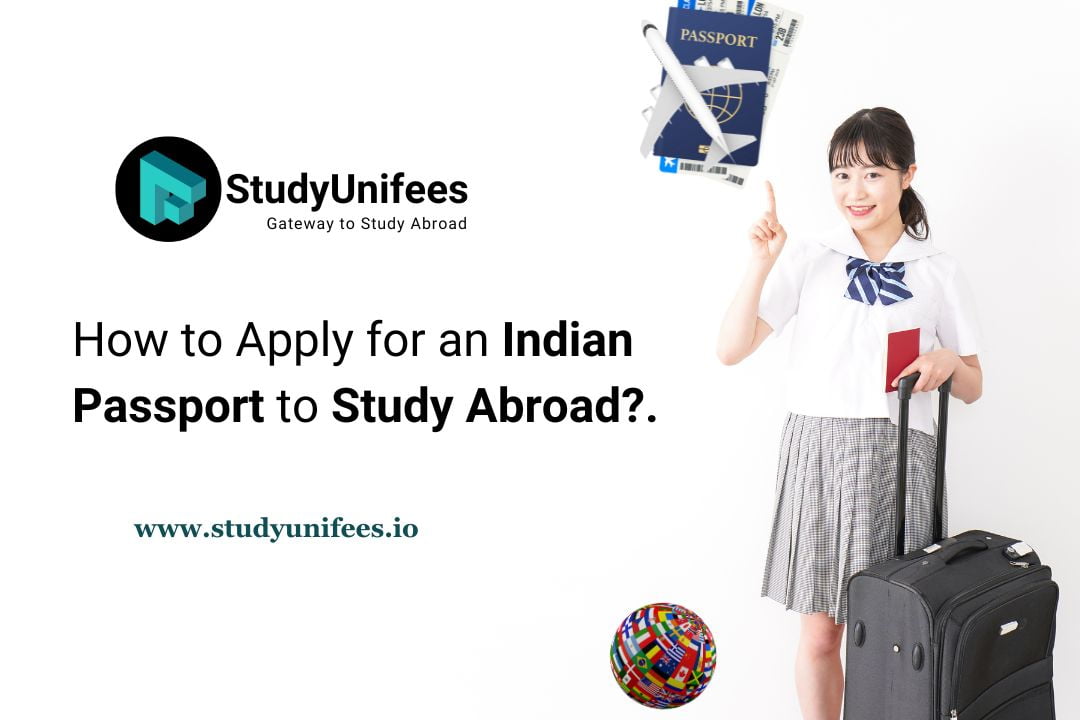Starting an academic journey abroad is a transformative experience, enabling one to engage with new cultural environments and learning landscapes. Central to this adventure is the process of obtaining an Indian passport and securing a student visa. In this article, we’ll walk you through the general procedure for acquiring an Indian passport, and discuss the specifics of obtaining a student visa in English-speaking countries, and explore visa-exempt destinations for Indian passport holders pursuing higher education.
Obtaining an Indian Passport
Step 1: Gather Required Documents
To initiate the passport application process, you’ll need the following documents:
- Proof of Identity: Gather documents such as an Aadhar card, voter ID, or any other government-issued photo ID, ensuring they meet the specified criteria.
- Proof of Address: Collect utility bills, rental agreements, or any document with your current address to establish your residency.
- Birth Certificate: Ensure you have a copy of your birth certificate as proof of your date and place of birth.
- Educational Documents: Keep your academic transcripts and certificates handy, as they may be required during the application process.
- Passport-size Photographs: Obtain recent color photographs meeting specific size and background criteria to comply with the passport photo guidelines.
Step 2: Online Application Submission
- Visit the Passport Seva Kendra (PSK) website: Navigate to the official website to initiate the application process.
- Register for an account or log in if you already have one: Create an account on the portal or log in with your existing credentials to access the application forms.
- Fill in the online application form with accurate information: Provide all necessary details, ensuring accuracy and consistency with the documents you’ve gathered.
- Choose the nearest Passport Seva Kendra for document verification and processing: Select a convenient location for document verification and processing, considering the available options on the portal.
Step 3: Pay the Applicable Fees
- Pay the passport application fee online: Use the online payment options provided to complete the payment for your passport application.
- Book an appointment at the selected Passport Seva Kendra for document verification: Schedule an appointment for document verification at the Passport Seva Kendra of your choice.
Step 4: Visit the Passport Seva Kendra
- Attend the scheduled appointment at the Passport Seva Kendra: Arrive on time for your appointment with all the required documents for verification.
- Submit the required documents for verification: Hand over your documents to the authorities for verification, including proof of identity, address, and educational qualifications.
- Provide biometric information, including fingerprints and a photograph: Complete the biometric data collection process as part of the identity verification procedure.
Step 5: Passport Processing
- Track the status of your passport application online: Utilize the online tracking system to monitor the progress of your passport application.
- Wait for the passport to be printed and dispatched: Once all verifications are complete, your passport will be processed, printed, and dispatched to the designated Passport Seva Kendra.
- Collect the passport from the Passport Seva Kendra or choose the home delivery option: Retrieve your passport from the Passport Seva Kendra or opt for home delivery as per your preference.
Obtaining a Student Visa Abroad
- Acceptance Letter: Begin by securing admission to a U.S. educational institution of your choice. This is a fundamental prerequisite for obtaining a student visa.
- SEVIS Fee Payment: After acceptance, pay the Student and Exchange Visitor Information System (SEVIS) fee, a crucial step in the U.S. student visa application process.
- Complete the DS-160 Form: Fill out the online visa application form, known as DS-160, providing accurate and truthful information.
- Schedule a Visa Interview: Book an appointment with the U.S. embassy or consulate for a visa interview. Be prepared to answer questions about your academic plans, financial status, and intent to return to India after completing your studies.
- Pay Visa Fee: Pay the non-refundable visa application fee as part of the application process.
- Attend Visa Interview: Attend the scheduled interview with all necessary documents, including your acceptance letter, SEVIS fee receipt, passport, and financial evidence.
- Receive Letter of Acceptance: Secure admission from a Canadian institution, which will serve as the foundation for your Canadian student visa application.
- Apply for a Canadian Student Visa (Study Permit): Submit an online application for a Canadian student visa, also known as a study permit. Include all required documentation, such as your letter of acceptance, proof of funds, and a valid passport.
- Provide Biometrics: Visit a Visa Application Center to provide biometric information, including fingerprints and a photograph.
- Medical Examination: Depending on your circumstances and the duration of your program, you may need to undergo a medical examination by an approved panel physician.
- Attend Visa Interview (if necessary): While not always required, some applicants may be asked to attend an interview as part of the visa processing.
- Wait for Visa Approval: Monitor the status of your visa application online and patiently await the decision on your study permit.
United Kingdom (UK)
- Secure Admission: Obtain an offer of admission from a recognized UK educational institution. This offer is a prerequisite for applying for a student visa.
- Apply for Confirmation of Acceptance for Studies (CAS): Once accepted, the institution will provide a Confirmation of Acceptance for Studies (CAS) number, which you’ll need for your visa application.
- Online Visa Application: Complete the online visa application form, providing accurate information and ensuring alignment with the details on your CAS.
- Biometric Appointment: Attend a biometric appointment at a designated visa application center, where your fingerprints and photograph will be collected.
- Pay the Health Surcharge: As part of the visa application process, pay the Immigration Health Surcharge, contributing to the National Health Service (NHS) during your stay.
- Book and Attend a Visa Interview (if necessary): Depending on your circumstances, you may be required to attend a visa interview. Prepare for questions related to your study abroad plans, financial capacity, and ties to India.
Australia
- Receive Confirmation of Enrolment (CoE): Obtain a Confirmation of Enrolment (CoE) from your chosen Australian educational institution, confirming your acceptance into a program.
- Online Visa Application (subclass 500): Lodge an online application for a student visa (subclass 500), providing accurate information and including all required documentation.
- Health Checkup: Complete a health examination if required, adhering to the health standards set by the Australian immigration authorities.
- Biometric Information: Provide biometric information at a Visa Application Center as part of the visa application process.
- Financial Proof: Demonstrate proof of sufficient funds to cover your tuition fees, living expenses, and other associated costs during your stay in Australia.
- Visa Decision: Await a decision on your student visa application, which you can track online.
New Zealand
- Acceptance by an Educational Institution: Secure acceptance from a New Zealand institution, ensuring you meet the admission requirements for your chosen program.
- Online Visa Application (Student Visa): Submit an online application for a New Zealand student visa, providing accurate information and attaching all required documents.
- Health and Character Requirements: Meet health and character requirements as stipulated by New Zealand immigration authorities, including a medical examination and character references.
- Financial Proof: Provide evidence of funds to cover your tuition fees, living expenses, and other costs during your studies in New Zealand.
- Biometric Information: If required, provide biometric information as part of the visa application process.
- Visa Approval: Await a decision on your student visa application, which you can track online through the New Zealand immigration portal.
Visa-Exempt Destinations for Indian Passport Holders
While many countries require Indian passport holders to obtain a visa for study abroad purposes, some destinations are visa-exempt or offer visa-on-arrival options:
- Nepal: Indian passport holders do not need a visa to study abroad in Nepal. The proximity and cultural ties between India and Nepal facilitate easy travel for educational purposes.
- Bhutan: As part of the strong diplomatic ties between India and Bhutan, Indian passport holders do not require a visa to study abroad in Bhutan.
- Maldives: Indian passport holders enjoy visa-free entry to the Maldives, making it a convenient destination for pursuing higher education.
- Seychelles: Seychelles allows Indian passport holders to enter the country without a visa, simplifying travel for academic pursuits.
- Mauritius: Indian passport holders can visit Mauritius without a visa, creating opportunities for study and exploration in this vibrant island nation.
Conclusion
Embarking on a journey to study abroad involves navigating the intricacies of passport acquisition and visa applications. The process, though intricate, is a vital step toward realizing the dream of studying in countries that offer world-class education. From obtaining an Indian passport to securing a student visa in English-speaking countries and exploring visa-exempt destinations, the journey is as exciting as the destination. Remember, thorough preparation, attention to detail, and timely completion of the required steps are key to a successful study abroad experience. The world awaits, and with the right documentation and a spirit of adventure, the possibilities are boundless.


